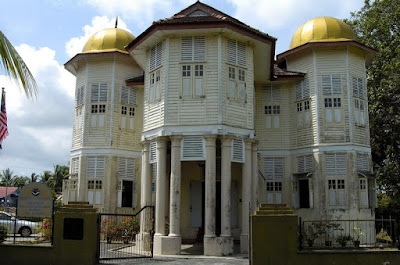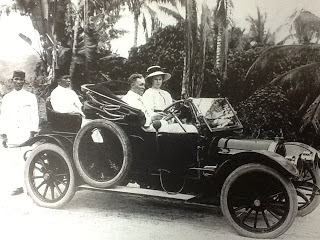Who is
Hang Tuah? A name that cannot be separated from the Malacca’s victorious
history since a long time ago. His historical name not only well known in Malacca but
also in Malaysia and South East Asia region.
Hang Tuah was a legendary Malay warrior who lived in Malacca during the
reign of Sultan Mansur Shah in the 15th century.
Considered
by many as a legend and a man with supernatural powers, Hang Tuah made a name
for himself as a great warrior during the Melaka Sultanate era. Together with
his four companions? Hang Jebat, Hang Kasturi, Hang Lekir and Hang Lekiu. The
five of them had been together all the times since their childhood.
It was
said that Hang Tuah’s parents, Dang Mahmud and Dang Merdu Wati, migrated from
Bentan to Malacca in their search of a better life where they finally settled down
at Kampung Duyung, Malacca. As a young boy, Hang Tuah worked as a woodcutter in
his parents’ shop. His grasp of spiritual concepts and potential as a fighter
were apparent from a young age.
During
the early days, Hang Tuah and his four friends embodied comradeship and stood
by each other by thick and thin. They even dug a well at their village which
came to be known as the Hang Tuah Well until today.
As they
grew older, Hang Tuah and his buddies learnt the Malay art of self-defence
(locally called as ‘Silat’) from a respected Tok Guru named Adiputra who lived
a hermetic life in a cave somewhere in a remote part at Gunung Ledang in Melaka.
They had been taught the arts of self-defense and meditation. With the skills,
all the five comrades helped in keeping the peace in Malacca.
The
turning point in Hang Tuah’s life came when he save the Dato’ Bendahara (chief
minister) from some men ran ‘amok’ in town. Dato Bendahara was amazed by the
courage of Hang Tuah and his companions. He rewarded them for their gallant and
presented them to Sultan of Malacca. When Sultan Mansor Shah (1456-1477) heard
about Hang Tuah’s bravery, Sultan had proudly awarded Hang Tuah the rank of Malacca
Admiral ‘Laksamana Melaka’ cum Syahbandar. His friends were also appointed to
be the Knights of Malacca.
Throughout the years, attending invitations
from foreign countries as far as China was the norm for the Sultan of Malacca
and Hang Tuah shall be constant aide to the Sultan on such visits. During the
sojourn to Majapahit, Taming Sari, a famous Majapahit warrior, had challenged
Hang Tuah for a duel. After a fiery fight, Hang Tuah finally emerged as the
winner and the Sultan of Majapahit bestowed Taming Sari’s Kris to Hang Tuah.
The Keris Taming Sari was named after its original owner and was purported to
be magical, empowering its owner with physical invulnerability.
Other responsibilities apart as ‘Laksamana’
and ‘Syahbandar’ of Malacca, Hang Tuah was always assigned to the task of being
the Sultan’s ambassador in fostering closer ties with allied
governments including China, India, Siam and Turkey.
According to Hikayat Hang Tuah, due to his loyalty
to the Sultan, Hang Tuah sailed to Inderaputra ( now is called ‘Pahang’) to
persuade Tun Teja, the princess of Inderapura to be the Queen of Sultan of
Malacca. Thinking that Hang Tuah himself would be marrying her, Tun Teja had
followed Hang Tuah on the way to Malacca. However, it was only during the voyage,
Hang Tuah had revealed the truth.
Hang Tuah’s popularity soon became the envy
of a few Malacca’s noblemen and this led to one of them, Pateh Karma Wijaya, to
create a story that Hang Tuah was having an affair with one of the palace’s
maid lady. Without further investigation, the Sultan had ordered Dato Bendahara
to carry out the death sentenced to Hang Tuah for the alleged offence. However,
Dato ‘Bendahara who know the truth, went against the Sultan’s orders and had hiddenly
located Hang Tuah somewhere in Ulu Melaka.
Believing that Hang Tuah was innocent and had
been sentenced to death, Hang Jebat decided to take a revenge on the death of his
beloved comrade, by first killing Dato Pateh Karma Wijaya. The Sultan was
unable to do anything as none of his warriors dared to challenge the ferocious
Hang Jebat. Only then Dato Bendahara finally revealed the secret to the Sultan
and told him that Hang Tuah was still alive. After hearing good news of that, Sultan
later instructed Hang Tuah to kill Hang Jebat, which he did after a long
grueling fight.
Another popular stories which was widely written
about Hang Tuah was his journey to
Gunung Ledang (Mount Ledang) at the Malacca-Johor border to ask for the hand of
the beautiful Princess of Mount Ledang for the Sultan’s wishes to be his Queen.
Having met the princess, Hang Tuah returned back to Malacca when she stated the
dowry or wedding gift which were include a Golden bridge linking Malacca and
the top of Mount Ledang, seven trays each of mosquitoes and germs liver, seven
jars of virgins’s tears and a bowl of Raja Ahmad’s blood(the Sultan’s son).
Hang Tuah was deeply disheartened when he
heard this, as he knew that the Sultan will not be able to fulfill the
conditions. Legend had stated that Hang
Tuah, who was overwhelmed by his disappointments, flung his kris into the
Malacca river and vowed only to return to Melaka if it resurfaced, which he
never did. He was finally vanished somewhere unknown.
However, it was not known how Hang Tuah died
but his body was said to be buried in Tanjung Kling, where his tomb can still
be seen until today.
The Tomb of Hang Tuah at Tanjung Kling, Malacca



































